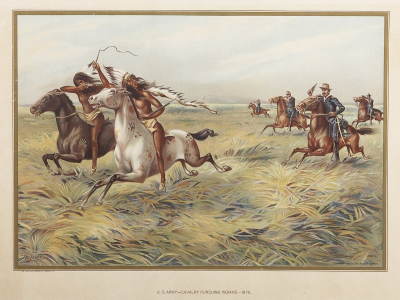The Battle of the Rosebud (also known as the Battle of Rosebud Creek) took place on June 17, 1876, in the Montana Territory between the United States Army and its Crow and Shoshoni allies against a force consisting mostly of Lakota Sioux and Northern Cheyenne Indians during the Great Sioux War of 1876. The Cheyenne called it the Battle Where the Girl Saved Her Brother because of an incident during the fight involving Buffalo Calf Road Woman. General George Crook's offensive was stymied by the Indians, led by Crazy Horse, and he awaited reinforcements before resuming the campaign in August.
The American Indian Wars, also known as the American Frontier Wars, the First Nations Wars in Canada (French: Guerres des Premières Nations), and the Indian Wars, were fought by European governments and colonists in North America, and later by the United States and Canadian governments and American and Canadian settlers, against various American Indian and First Nation tribes. These conflicts occurred in North America from the time of the earliest colonial settlements in the 17th century until the early 20th century. The various wars resulted from a wide variety of factors. The European powers and their colonies also enlisted allied Indian tribes to help them conduct warfare against each other's colonial settlements. After the American Revolution, many conflicts were local to specific states or regions and frequently involved disputes over land use; some entailed cycles of violent reprisal.
As settlers spread westward across North America after 1780, armed conflicts increased in size, duration, and intensity between settlers and various Indian and First Nation tribes. The climax came in the War of 1812, when major Indian coalitions in the Midwest and the South fought against the United States and lost. Conflict with settlers became much less common and was usually resolved by treaty, often through sale or exchange of territory between the federal government and specific tribes. The Indian Removal Act of 1830 authorized the American government to enforce Indian removal from east of the Mississippi River to Indian Territory west on the American frontier, especially what became Oklahoma. The federal policy of removal was eventually refined in the West, as American settlers kept expanding their territories, to relocate Indian tribes to reservations.

1876Jun, 17
American Indian Wars: Battle of the Rosebud: One thousand five hundred Sioux and Cheyenne led by Crazy Horse beat back General George Crook's forces at Rosebud Creek in Montana Territory.
Choose Another Date
Events on 1876
- 2Feb
Major League Baseball
The National League of Professional Baseball Clubs of Major League Baseball is formed. - 10Mar
Alexander Graham Bell
The first successful test of a telephone is made by Alexander Graham Bell. - 22Apr
MLB
The first game in the history of the National League was played at the Jefferson Street Grounds in Philadelphia. This game is often pointed to as the beginning of the MLB. - 4Jun
First Transcontinental Railroad
An express train called the Transcontinental Express arrives in San Francisco, via the First Transcontinental Railroad only 83 hours and 39 minutes after leaving New York City. - 25Nov
Battle of the Little Bighorn
American Indian Wars: In retaliation for the American defeat at the Battle of the Little Bighorn, United States Army troops sack the sleeping village of Cheyenne Chief Dull Knife at the headwaters of the Powder River.

 English
English  español
español  français
français  português
português  русский
русский  العربية
العربية  简体中文
简体中文 